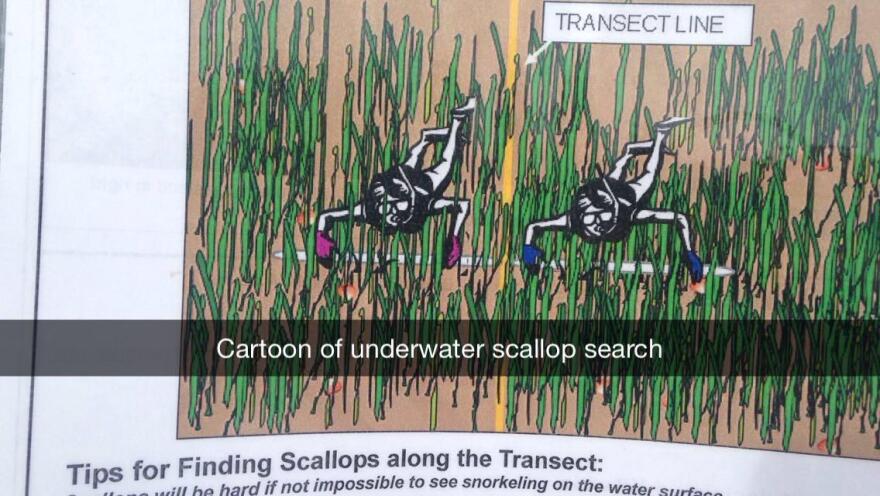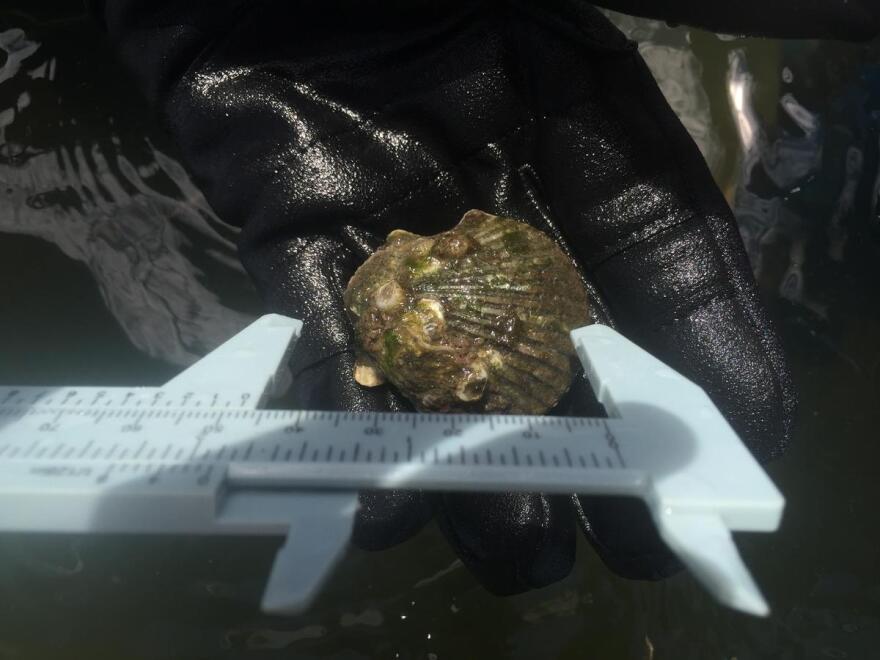Local volunteers snorkeled Pine Island Sound recently to count scallops. It was the sixth annual Great Bay Scallop Search in Lee County. Scallop numbers were so low in the 1980s, it caused a local fishery to close. Now, Florida Sea Grant is checking to see if those numbers are bouncing back.
It was morning at Pineland Marina. About 120 volunteers were gathered around Joy Hazell.
She organizes the Great Bay Scallop Search every year for Florida Sea Grant. It’s a University of Florida-based research program tasked with conserving coastal resources.

"You have a close-up map of your grid, so that's where you're assigned," Hazell said to her volunteers.
She organizes the Great Bay Scallop Search every year for Florida Sea Grant. It’s a University of Florida based research program tasked with conserving coastal resources.
This event gives a glimpse of how the Bay scallop population is doing in Pine Island Sound.
Hazell demonstrated the proper way to snorkel while searching for scallops in the brackish water.
She said to first throw in a 50-meter rope line that has weights on either end. Hazell calls this line the “transect.”
"You're gonna gave two divers who will snorkel the length of the transect and count scallops," she said.
She held a meter-long white stick in front of her. Snorkelers use the stick to push down sea grass and see the scallops better underwater.
After the training, everyone separated into their boats. I got on a 22-foot-long boat with five other people.

About ten minutes in, my group chose a good spot to begin looking for scallops.
"We're getting into shallower water," said Paul Riley, a first-time volunteer. "You can see all the grass here, so we're at just over a meter."About ten minutes in, my group chose a good spot to begin looking for scallops.
He learned from Joy Hazell’s presentation that it’s easiest to find scallops in shallow water.
Four volunteers swam out to conduct their first search. Nancy Kilmartin with Lee County Parks and Recreation Department stayed on the boat. She has joined the search every year.
She was ready to write down any data the snorkelers would shout out. They had to collect water levels, types of sea grass and any other aquatic life they find along the way.
Kilmartin laughed as she described her view of the scavenger hunt: "A lot of legs and butts," she said.

After about 20 minutes, the group swam back empty-handed.
“No scallops?” Kilmartin asked the group.
“One dead-- dead scallop half-shell," said Nikhil Mehta, a local biologist.
He and the others only found one white scallop half-shell. Mehta said it was bleached, indicating it had been dead for a while.
The snorkelers climbed back into the boat and trekked on, searching for their next destination. And they found it, stopping near a thick patch of black mangroves.
Mehta splashed into the water and said, "Oh this is perfect. See this depth? Jessica, you gotta put your mask on and get in-- this site is a really good site."
So, I turned off my recorder, put on my snorkel gear and stepped barefoot onto the stringy sea grass and slimy muck.
I submerged my masked-face into the yellow water, and saw the ribbons of green grass flowing around me.
Not too long after I joined in, Paul Riley—the first-timer—found a live scallop.
"It's pretty cool to actually find a live scallop," said Riley. "The muck is real squishy, so almost like the consistency of applesauce. And just feeling around in there and felt the ridges of the scallop shell."

Biologist Nikhil Mehta held the scallop in the palm of his hand to measure it. Then, the scallop slowly opened up, revealing dozens of little bright blue eyes along the edge of its shell.
After gathering the necessary data, Mehta put the scallop back where Riley found it. That scallop would be the only one the group found that day.
Biologist Nikhil Mehta held the scallop in the palm of his hand to measure it. Then, the scallop slowly opened up, revealing dozens of little bright blue eyes along the edge of its shell.
Back at Pineland Marina, Joy Hazell with Florida Sea Grant said finding just one scallop is still significant.
"It's still important information. So all of these numbers are telling a story and that's how science works," she said.
The volunteers only found 32 scallops, compared with 44 last year. But Hazell said snorkelers found scallops in more areas this year than ever before.
"It means that we have more spots in the Sound that have the habitat that can support scallops," said Hazell. "And that's always good because what that means is we've got good water quality and we've got good sea grass coverage."
But about 30 years ago, sea grasses and water quality were so poor, they caused the collapse of the local scallop fishery. Hazell said based on this new data, the overall health of Pine Island Sound seems to be improving.
"So that's why we're looking at this going, 'OK maybe it's in good enough shape to support a Bay Scallop population again,'" she said.
Hazell said she will send the information to the Florida Fish and Wildlife Conservation Commission. The numbers will ultimately contribute to a state-wide count.






